Fashion Retail and Market Analysis: Next Plc UK Market Report
VerifiedAdded on 2020/10/22
|12
|4013
|328
Report
AI Summary
This report provides a comprehensive analysis of Next Plc, a major player in the UK fashion retail market. It begins with an introduction to retail and fashion retail, describing Next Plc's business model, features, and market position. The report then examines the changes in the fashion clothing market, highlighting shifts in distribution channels and the evolution of retail marketing. A PESTEL analysis is conducted to assess the political, economic, social, technological, environmental, and legal factors impacting Next Plc's performance. Furthermore, Porter's Five Forces analysis is used to evaluate the competitive forces within the retail industry. The report also addresses the company's challenges and opportunities. Overall, the report offers insights into the strategies and adaptations required for success in the dynamic fashion retail environment.
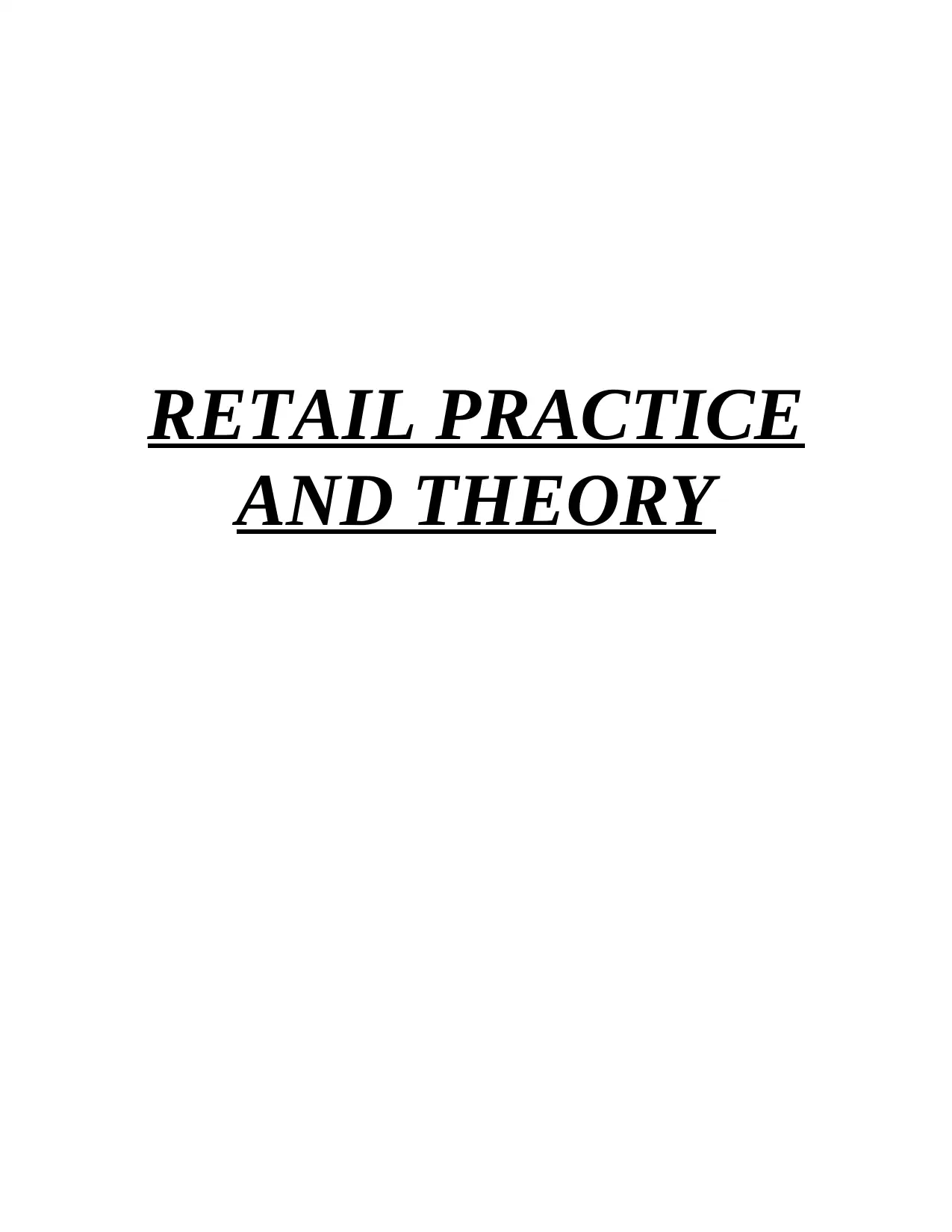
RETAIL PRACTICE
AND THEORY
AND THEORY
Paraphrase This Document
Need a fresh take? Get an instant paraphrase of this document with our AI Paraphraser
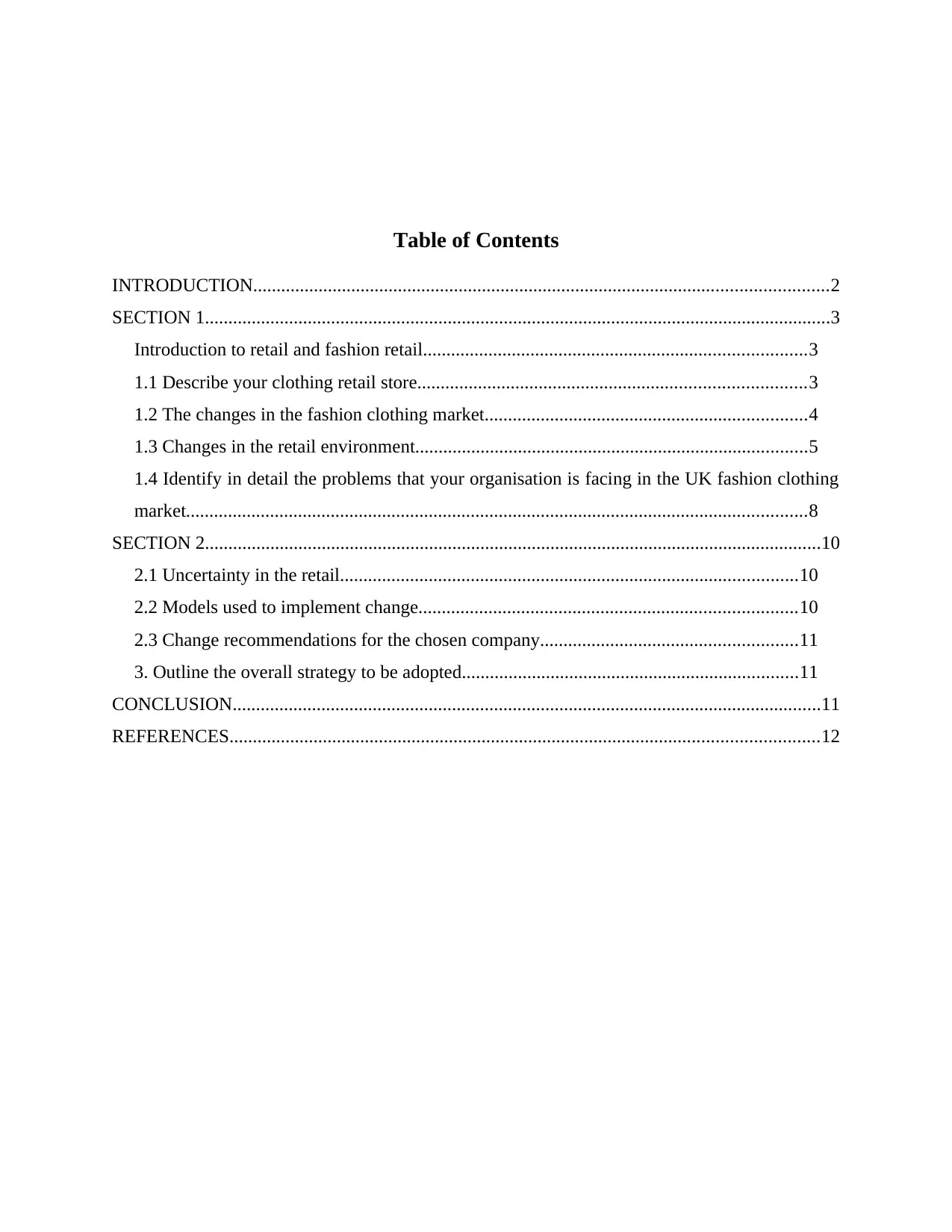
Table of Contents
INTRODUCTION...........................................................................................................................2
SECTION 1......................................................................................................................................3
Introduction to retail and fashion retail..................................................................................3
1.1 Describe your clothing retail store...................................................................................3
1.2 The changes in the fashion clothing market.....................................................................4
1.3 Changes in the retail environment....................................................................................5
1.4 Identify in detail the problems that your organisation is facing in the UK fashion clothing
market.....................................................................................................................................8
SECTION 2....................................................................................................................................10
2.1 Uncertainty in the retail..................................................................................................10
2.2 Models used to implement change.................................................................................10
2.3 Change recommendations for the chosen company.......................................................11
3. Outline the overall strategy to be adopted........................................................................11
CONCLUSION..............................................................................................................................11
REFERENCES..............................................................................................................................12
INTRODUCTION...........................................................................................................................2
SECTION 1......................................................................................................................................3
Introduction to retail and fashion retail..................................................................................3
1.1 Describe your clothing retail store...................................................................................3
1.2 The changes in the fashion clothing market.....................................................................4
1.3 Changes in the retail environment....................................................................................5
1.4 Identify in detail the problems that your organisation is facing in the UK fashion clothing
market.....................................................................................................................................8
SECTION 2....................................................................................................................................10
2.1 Uncertainty in the retail..................................................................................................10
2.2 Models used to implement change.................................................................................10
2.3 Change recommendations for the chosen company.......................................................11
3. Outline the overall strategy to be adopted........................................................................11
CONCLUSION..............................................................................................................................11
REFERENCES..............................................................................................................................12
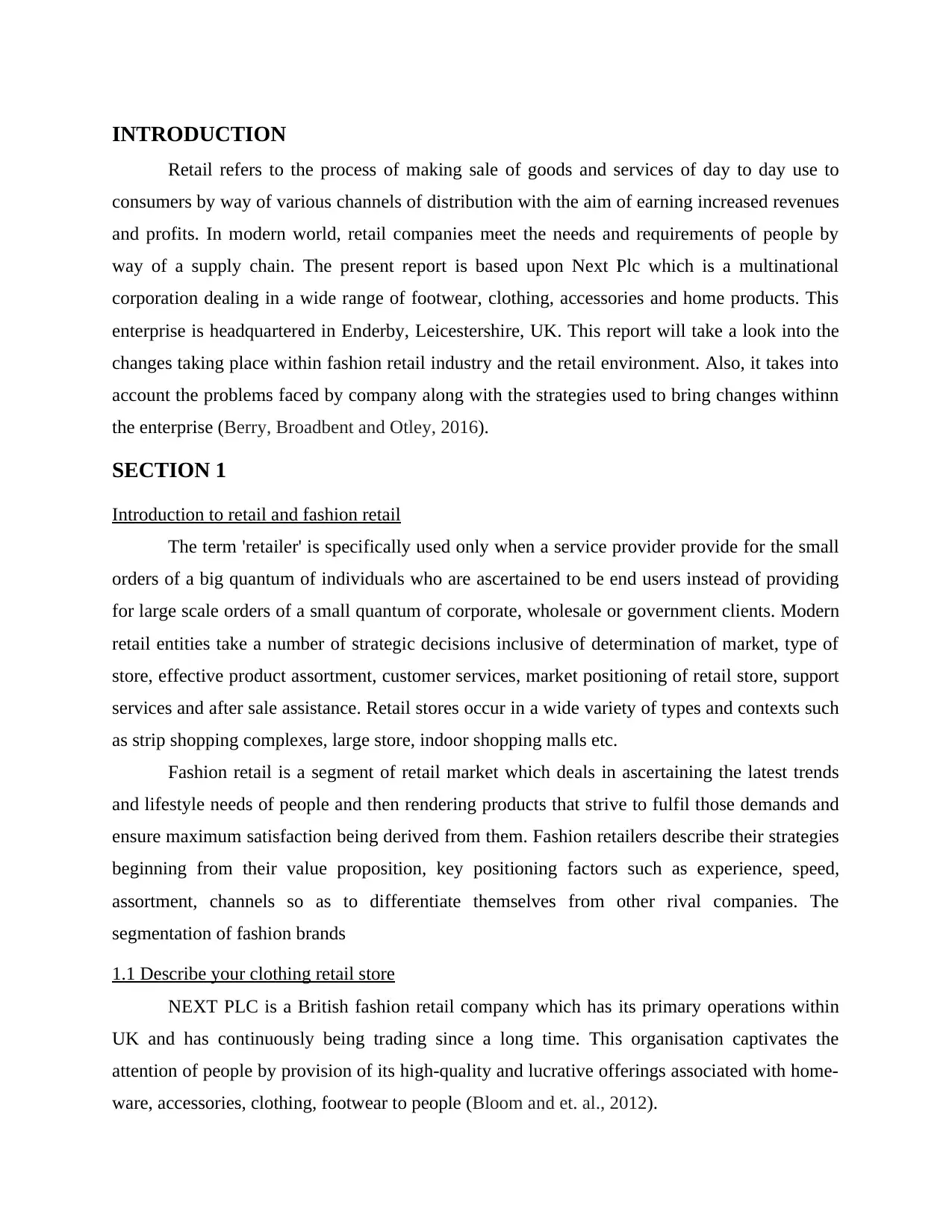
INTRODUCTION
Retail refers to the process of making sale of goods and services of day to day use to
consumers by way of various channels of distribution with the aim of earning increased revenues
and profits. In modern world, retail companies meet the needs and requirements of people by
way of a supply chain. The present report is based upon Next Plc which is a multinational
corporation dealing in a wide range of footwear, clothing, accessories and home products. This
enterprise is headquartered in Enderby, Leicestershire, UK. This report will take a look into the
changes taking place within fashion retail industry and the retail environment. Also, it takes into
account the problems faced by company along with the strategies used to bring changes withinn
the enterprise (Berry, Broadbent and Otley, 2016).
SECTION 1
Introduction to retail and fashion retail
The term 'retailer' is specifically used only when a service provider provide for the small
orders of a big quantum of individuals who are ascertained to be end users instead of providing
for large scale orders of a small quantum of corporate, wholesale or government clients. Modern
retail entities take a number of strategic decisions inclusive of determination of market, type of
store, effective product assortment, customer services, market positioning of retail store, support
services and after sale assistance. Retail stores occur in a wide variety of types and contexts such
as strip shopping complexes, large store, indoor shopping malls etc.
Fashion retail is a segment of retail market which deals in ascertaining the latest trends
and lifestyle needs of people and then rendering products that strive to fulfil those demands and
ensure maximum satisfaction being derived from them. Fashion retailers describe their strategies
beginning from their value proposition, key positioning factors such as experience, speed,
assortment, channels so as to differentiate themselves from other rival companies. The
segmentation of fashion brands
1.1 Describe your clothing retail store
NEXT PLC is a British fashion retail company which has its primary operations within
UK and has continuously being trading since a long time. This organisation captivates the
attention of people by provision of its high-quality and lucrative offerings associated with home-
ware, accessories, clothing, footwear to people (Bloom and et. al., 2012).
Retail refers to the process of making sale of goods and services of day to day use to
consumers by way of various channels of distribution with the aim of earning increased revenues
and profits. In modern world, retail companies meet the needs and requirements of people by
way of a supply chain. The present report is based upon Next Plc which is a multinational
corporation dealing in a wide range of footwear, clothing, accessories and home products. This
enterprise is headquartered in Enderby, Leicestershire, UK. This report will take a look into the
changes taking place within fashion retail industry and the retail environment. Also, it takes into
account the problems faced by company along with the strategies used to bring changes withinn
the enterprise (Berry, Broadbent and Otley, 2016).
SECTION 1
Introduction to retail and fashion retail
The term 'retailer' is specifically used only when a service provider provide for the small
orders of a big quantum of individuals who are ascertained to be end users instead of providing
for large scale orders of a small quantum of corporate, wholesale or government clients. Modern
retail entities take a number of strategic decisions inclusive of determination of market, type of
store, effective product assortment, customer services, market positioning of retail store, support
services and after sale assistance. Retail stores occur in a wide variety of types and contexts such
as strip shopping complexes, large store, indoor shopping malls etc.
Fashion retail is a segment of retail market which deals in ascertaining the latest trends
and lifestyle needs of people and then rendering products that strive to fulfil those demands and
ensure maximum satisfaction being derived from them. Fashion retailers describe their strategies
beginning from their value proposition, key positioning factors such as experience, speed,
assortment, channels so as to differentiate themselves from other rival companies. The
segmentation of fashion brands
1.1 Describe your clothing retail store
NEXT PLC is a British fashion retail company which has its primary operations within
UK and has continuously being trading since a long time. This organisation captivates the
attention of people by provision of its high-quality and lucrative offerings associated with home-
ware, accessories, clothing, footwear to people (Bloom and et. al., 2012).
⊘ This is a preview!⊘
Do you want full access?
Subscribe today to unlock all pages.

Trusted by 1+ million students worldwide
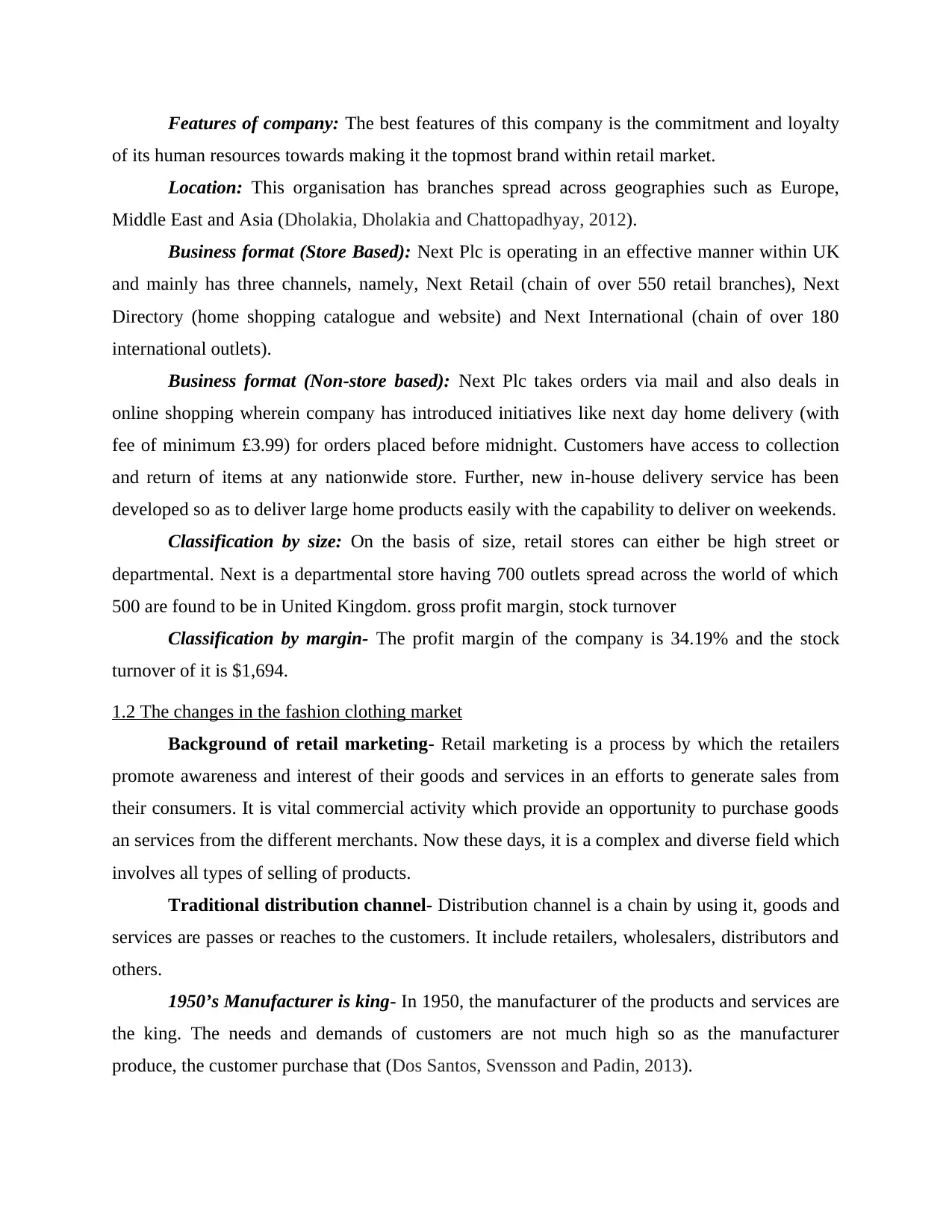
Features of company: The best features of this company is the commitment and loyalty
of its human resources towards making it the topmost brand within retail market.
Location: This organisation has branches spread across geographies such as Europe,
Middle East and Asia (Dholakia, Dholakia and Chattopadhyay, 2012).
Business format (Store Based): Next Plc is operating in an effective manner within UK
and mainly has three channels, namely, Next Retail (chain of over 550 retail branches), Next
Directory (home shopping catalogue and website) and Next International (chain of over 180
international outlets).
Business format (Non-store based): Next Plc takes orders via mail and also deals in
online shopping wherein company has introduced initiatives like next day home delivery (with
fee of minimum £3.99) for orders placed before midnight. Customers have access to collection
and return of items at any nationwide store. Further, new in-house delivery service has been
developed so as to deliver large home products easily with the capability to deliver on weekends.
Classification by size: On the basis of size, retail stores can either be high street or
departmental. Next is a departmental store having 700 outlets spread across the world of which
500 are found to be in United Kingdom. gross profit margin, stock turnover
Classification by margin- The profit margin of the company is 34.19% and the stock
turnover of it is $1,694.
1.2 The changes in the fashion clothing market
Background of retail marketing- Retail marketing is a process by which the retailers
promote awareness and interest of their goods and services in an efforts to generate sales from
their consumers. It is vital commercial activity which provide an opportunity to purchase goods
an services from the different merchants. Now these days, it is a complex and diverse field which
involves all types of selling of products.
Traditional distribution channel- Distribution channel is a chain by using it, goods and
services are passes or reaches to the customers. It include retailers, wholesalers, distributors and
others.
1950’s Manufacturer is king- In 1950, the manufacturer of the products and services are
the king. The needs and demands of customers are not much high so as the manufacturer
produce, the customer purchase that (Dos Santos, Svensson and Padin, 2013).
of its human resources towards making it the topmost brand within retail market.
Location: This organisation has branches spread across geographies such as Europe,
Middle East and Asia (Dholakia, Dholakia and Chattopadhyay, 2012).
Business format (Store Based): Next Plc is operating in an effective manner within UK
and mainly has three channels, namely, Next Retail (chain of over 550 retail branches), Next
Directory (home shopping catalogue and website) and Next International (chain of over 180
international outlets).
Business format (Non-store based): Next Plc takes orders via mail and also deals in
online shopping wherein company has introduced initiatives like next day home delivery (with
fee of minimum £3.99) for orders placed before midnight. Customers have access to collection
and return of items at any nationwide store. Further, new in-house delivery service has been
developed so as to deliver large home products easily with the capability to deliver on weekends.
Classification by size: On the basis of size, retail stores can either be high street or
departmental. Next is a departmental store having 700 outlets spread across the world of which
500 are found to be in United Kingdom. gross profit margin, stock turnover
Classification by margin- The profit margin of the company is 34.19% and the stock
turnover of it is $1,694.
1.2 The changes in the fashion clothing market
Background of retail marketing- Retail marketing is a process by which the retailers
promote awareness and interest of their goods and services in an efforts to generate sales from
their consumers. It is vital commercial activity which provide an opportunity to purchase goods
an services from the different merchants. Now these days, it is a complex and diverse field which
involves all types of selling of products.
Traditional distribution channel- Distribution channel is a chain by using it, goods and
services are passes or reaches to the customers. It include retailers, wholesalers, distributors and
others.
1950’s Manufacturer is king- In 1950, the manufacturer of the products and services are
the king. The needs and demands of customers are not much high so as the manufacturer
produce, the customer purchase that (Dos Santos, Svensson and Padin, 2013).
Paraphrase This Document
Need a fresh take? Get an instant paraphrase of this document with our AI Paraphraser
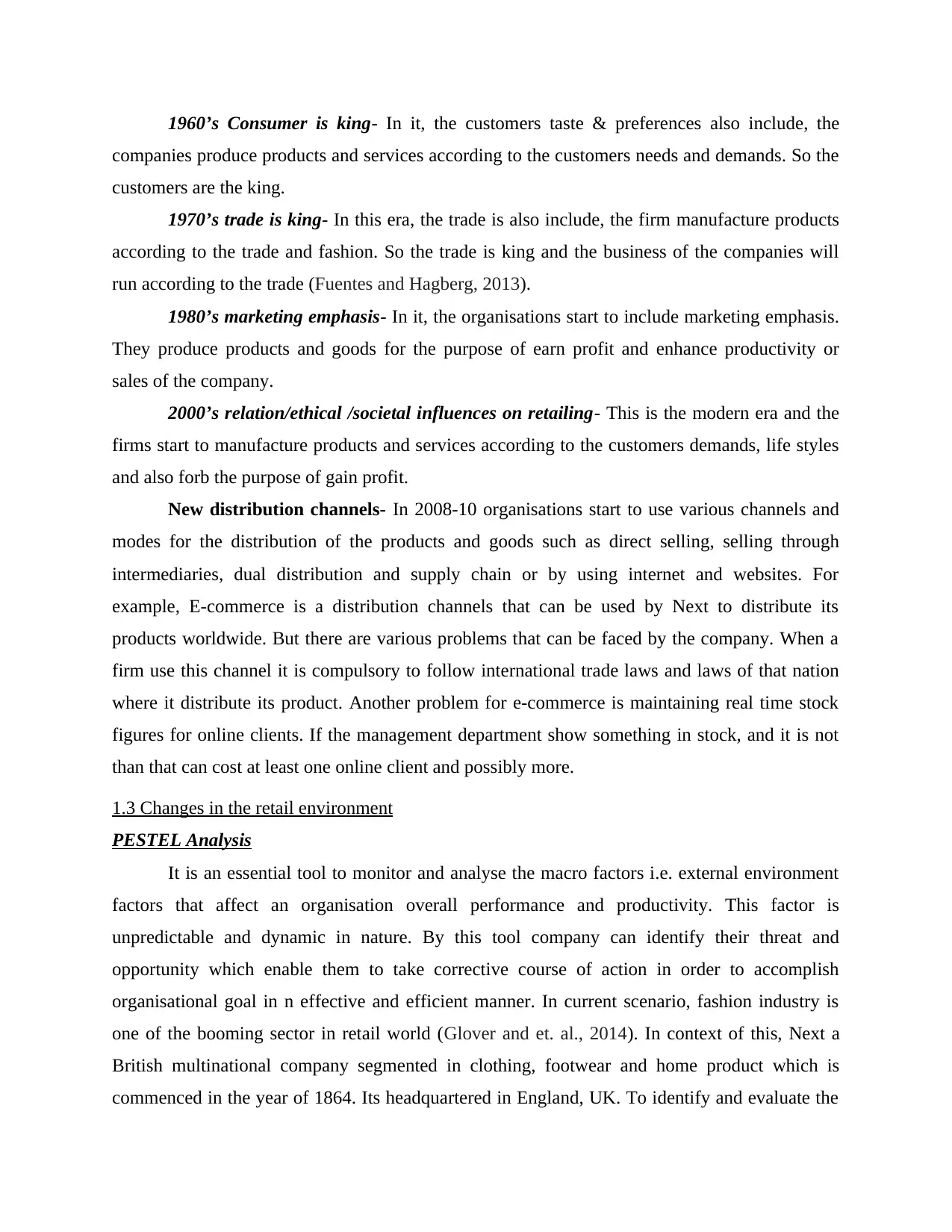
1960’s Consumer is king- In it, the customers taste & preferences also include, the
companies produce products and services according to the customers needs and demands. So the
customers are the king.
1970’s trade is king- In this era, the trade is also include, the firm manufacture products
according to the trade and fashion. So the trade is king and the business of the companies will
run according to the trade (Fuentes and Hagberg, 2013).
1980’s marketing emphasis- In it, the organisations start to include marketing emphasis.
They produce products and goods for the purpose of earn profit and enhance productivity or
sales of the company.
2000’s relation/ethical /societal influences on retailing- This is the modern era and the
firms start to manufacture products and services according to the customers demands, life styles
and also forb the purpose of gain profit.
New distribution channels- In 2008-10 organisations start to use various channels and
modes for the distribution of the products and goods such as direct selling, selling through
intermediaries, dual distribution and supply chain or by using internet and websites. For
example, E-commerce is a distribution channels that can be used by Next to distribute its
products worldwide. But there are various problems that can be faced by the company. When a
firm use this channel it is compulsory to follow international trade laws and laws of that nation
where it distribute its product. Another problem for e-commerce is maintaining real time stock
figures for online clients. If the management department show something in stock, and it is not
than that can cost at least one online client and possibly more.
1.3 Changes in the retail environment
PESTEL Analysis
It is an essential tool to monitor and analyse the macro factors i.e. external environment
factors that affect an organisation overall performance and productivity. This factor is
unpredictable and dynamic in nature. By this tool company can identify their threat and
opportunity which enable them to take corrective course of action in order to accomplish
organisational goal in n effective and efficient manner. In current scenario, fashion industry is
one of the booming sector in retail world (Glover and et. al., 2014). In context of this, Next a
British multinational company segmented in clothing, footwear and home product which is
commenced in the year of 1864. Its headquartered in England, UK. To identify and evaluate the
companies produce products and services according to the customers needs and demands. So the
customers are the king.
1970’s trade is king- In this era, the trade is also include, the firm manufacture products
according to the trade and fashion. So the trade is king and the business of the companies will
run according to the trade (Fuentes and Hagberg, 2013).
1980’s marketing emphasis- In it, the organisations start to include marketing emphasis.
They produce products and goods for the purpose of earn profit and enhance productivity or
sales of the company.
2000’s relation/ethical /societal influences on retailing- This is the modern era and the
firms start to manufacture products and services according to the customers demands, life styles
and also forb the purpose of gain profit.
New distribution channels- In 2008-10 organisations start to use various channels and
modes for the distribution of the products and goods such as direct selling, selling through
intermediaries, dual distribution and supply chain or by using internet and websites. For
example, E-commerce is a distribution channels that can be used by Next to distribute its
products worldwide. But there are various problems that can be faced by the company. When a
firm use this channel it is compulsory to follow international trade laws and laws of that nation
where it distribute its product. Another problem for e-commerce is maintaining real time stock
figures for online clients. If the management department show something in stock, and it is not
than that can cost at least one online client and possibly more.
1.3 Changes in the retail environment
PESTEL Analysis
It is an essential tool to monitor and analyse the macro factors i.e. external environment
factors that affect an organisation overall performance and productivity. This factor is
unpredictable and dynamic in nature. By this tool company can identify their threat and
opportunity which enable them to take corrective course of action in order to accomplish
organisational goal in n effective and efficient manner. In current scenario, fashion industry is
one of the booming sector in retail world (Glover and et. al., 2014). In context of this, Next a
British multinational company segmented in clothing, footwear and home product which is
commenced in the year of 1864. Its headquartered in England, UK. To identify and evaluate the
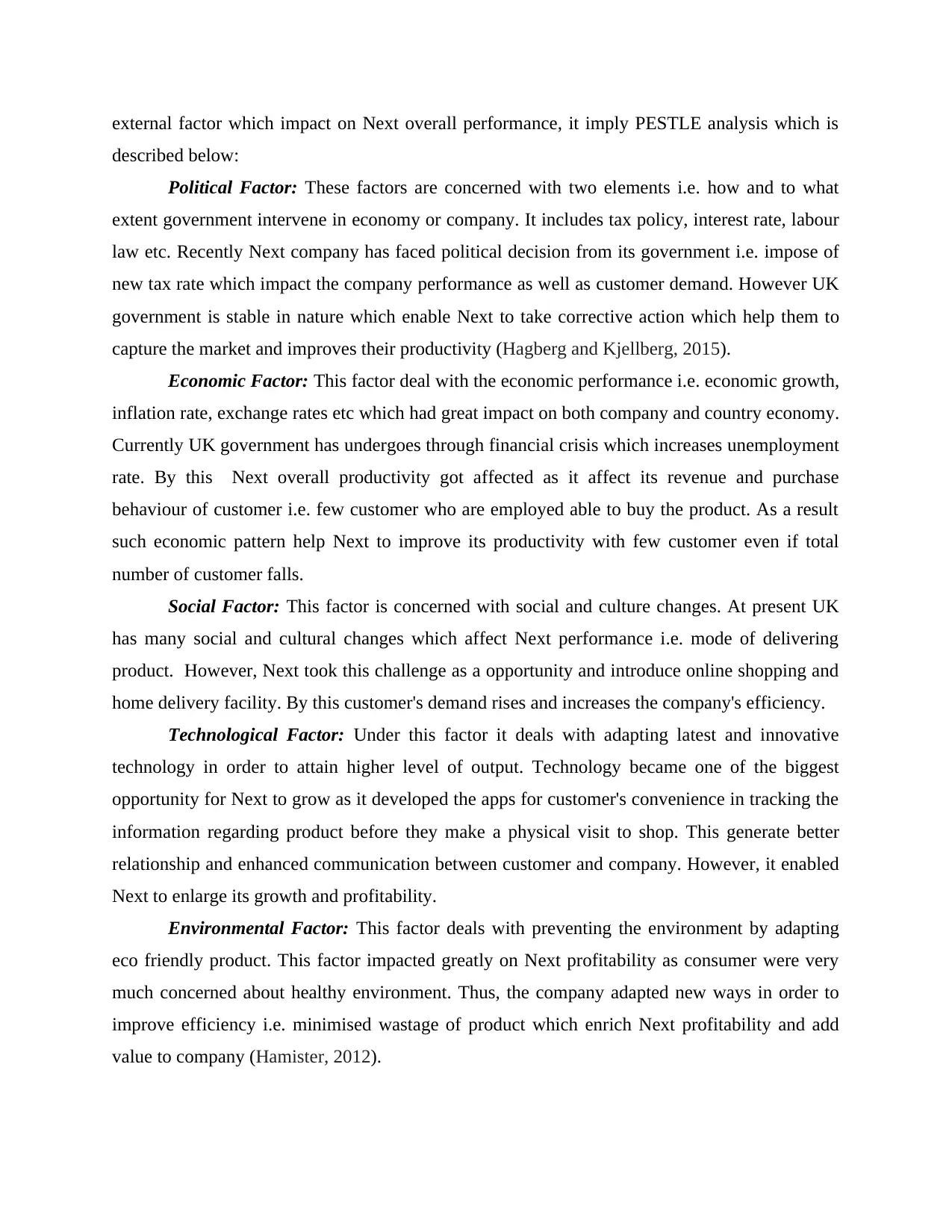
external factor which impact on Next overall performance, it imply PESTLE analysis which is
described below:
Political Factor: These factors are concerned with two elements i.e. how and to what
extent government intervene in economy or company. It includes tax policy, interest rate, labour
law etc. Recently Next company has faced political decision from its government i.e. impose of
new tax rate which impact the company performance as well as customer demand. However UK
government is stable in nature which enable Next to take corrective action which help them to
capture the market and improves their productivity (Hagberg and Kjellberg, 2015).
Economic Factor: This factor deal with the economic performance i.e. economic growth,
inflation rate, exchange rates etc which had great impact on both company and country economy.
Currently UK government has undergoes through financial crisis which increases unemployment
rate. By this Next overall productivity got affected as it affect its revenue and purchase
behaviour of customer i.e. few customer who are employed able to buy the product. As a result
such economic pattern help Next to improve its productivity with few customer even if total
number of customer falls.
Social Factor: This factor is concerned with social and culture changes. At present UK
has many social and cultural changes which affect Next performance i.e. mode of delivering
product. However, Next took this challenge as a opportunity and introduce online shopping and
home delivery facility. By this customer's demand rises and increases the company's efficiency.
Technological Factor: Under this factor it deals with adapting latest and innovative
technology in order to attain higher level of output. Technology became one of the biggest
opportunity for Next to grow as it developed the apps for customer's convenience in tracking the
information regarding product before they make a physical visit to shop. This generate better
relationship and enhanced communication between customer and company. However, it enabled
Next to enlarge its growth and profitability.
Environmental Factor: This factor deals with preventing the environment by adapting
eco friendly product. This factor impacted greatly on Next profitability as consumer were very
much concerned about healthy environment. Thus, the company adapted new ways in order to
improve efficiency i.e. minimised wastage of product which enrich Next profitability and add
value to company (Hamister, 2012).
described below:
Political Factor: These factors are concerned with two elements i.e. how and to what
extent government intervene in economy or company. It includes tax policy, interest rate, labour
law etc. Recently Next company has faced political decision from its government i.e. impose of
new tax rate which impact the company performance as well as customer demand. However UK
government is stable in nature which enable Next to take corrective action which help them to
capture the market and improves their productivity (Hagberg and Kjellberg, 2015).
Economic Factor: This factor deal with the economic performance i.e. economic growth,
inflation rate, exchange rates etc which had great impact on both company and country economy.
Currently UK government has undergoes through financial crisis which increases unemployment
rate. By this Next overall productivity got affected as it affect its revenue and purchase
behaviour of customer i.e. few customer who are employed able to buy the product. As a result
such economic pattern help Next to improve its productivity with few customer even if total
number of customer falls.
Social Factor: This factor is concerned with social and culture changes. At present UK
has many social and cultural changes which affect Next performance i.e. mode of delivering
product. However, Next took this challenge as a opportunity and introduce online shopping and
home delivery facility. By this customer's demand rises and increases the company's efficiency.
Technological Factor: Under this factor it deals with adapting latest and innovative
technology in order to attain higher level of output. Technology became one of the biggest
opportunity for Next to grow as it developed the apps for customer's convenience in tracking the
information regarding product before they make a physical visit to shop. This generate better
relationship and enhanced communication between customer and company. However, it enabled
Next to enlarge its growth and profitability.
Environmental Factor: This factor deals with preventing the environment by adapting
eco friendly product. This factor impacted greatly on Next profitability as consumer were very
much concerned about healthy environment. Thus, the company adapted new ways in order to
improve efficiency i.e. minimised wastage of product which enrich Next profitability and add
value to company (Hamister, 2012).
⊘ This is a preview!⊘
Do you want full access?
Subscribe today to unlock all pages.

Trusted by 1+ million students worldwide
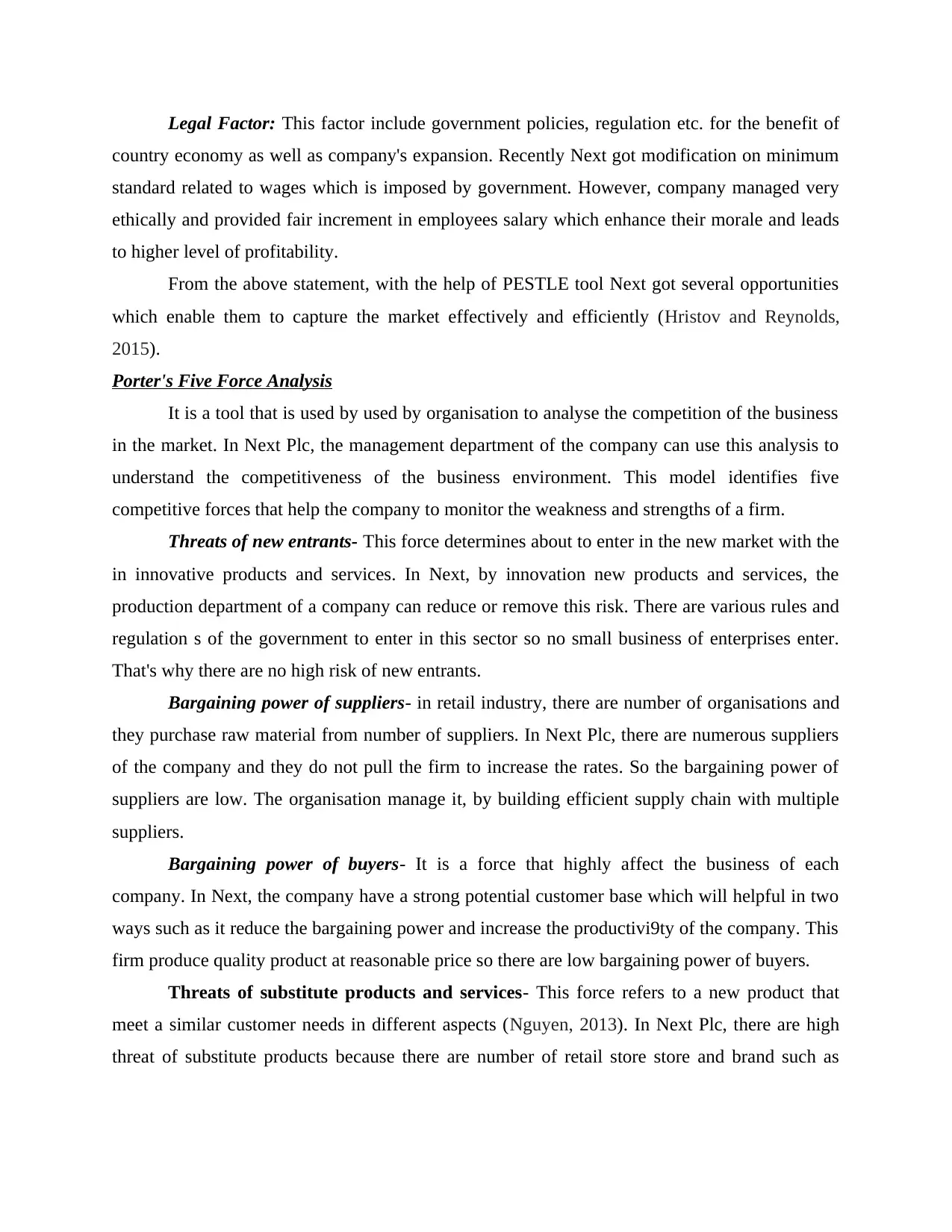
Legal Factor: This factor include government policies, regulation etc. for the benefit of
country economy as well as company's expansion. Recently Next got modification on minimum
standard related to wages which is imposed by government. However, company managed very
ethically and provided fair increment in employees salary which enhance their morale and leads
to higher level of profitability.
From the above statement, with the help of PESTLE tool Next got several opportunities
which enable them to capture the market effectively and efficiently (Hristov and Reynolds,
2015).
Porter's Five Force Analysis
It is a tool that is used by used by organisation to analyse the competition of the business
in the market. In Next Plc, the management department of the company can use this analysis to
understand the competitiveness of the business environment. This model identifies five
competitive forces that help the company to monitor the weakness and strengths of a firm.
Threats of new entrants- This force determines about to enter in the new market with the
in innovative products and services. In Next, by innovation new products and services, the
production department of a company can reduce or remove this risk. There are various rules and
regulation s of the government to enter in this sector so no small business of enterprises enter.
That's why there are no high risk of new entrants.
Bargaining power of suppliers- in retail industry, there are number of organisations and
they purchase raw material from number of suppliers. In Next Plc, there are numerous suppliers
of the company and they do not pull the firm to increase the rates. So the bargaining power of
suppliers are low. The organisation manage it, by building efficient supply chain with multiple
suppliers.
Bargaining power of buyers- It is a force that highly affect the business of each
company. In Next, the company have a strong potential customer base which will helpful in two
ways such as it reduce the bargaining power and increase the productivi9ty of the company. This
firm produce quality product at reasonable price so there are low bargaining power of buyers.
Threats of substitute products and services- This force refers to a new product that
meet a similar customer needs in different aspects (Nguyen, 2013). In Next Plc, there are high
threat of substitute products because there are number of retail store store and brand such as
country economy as well as company's expansion. Recently Next got modification on minimum
standard related to wages which is imposed by government. However, company managed very
ethically and provided fair increment in employees salary which enhance their morale and leads
to higher level of profitability.
From the above statement, with the help of PESTLE tool Next got several opportunities
which enable them to capture the market effectively and efficiently (Hristov and Reynolds,
2015).
Porter's Five Force Analysis
It is a tool that is used by used by organisation to analyse the competition of the business
in the market. In Next Plc, the management department of the company can use this analysis to
understand the competitiveness of the business environment. This model identifies five
competitive forces that help the company to monitor the weakness and strengths of a firm.
Threats of new entrants- This force determines about to enter in the new market with the
in innovative products and services. In Next, by innovation new products and services, the
production department of a company can reduce or remove this risk. There are various rules and
regulation s of the government to enter in this sector so no small business of enterprises enter.
That's why there are no high risk of new entrants.
Bargaining power of suppliers- in retail industry, there are number of organisations and
they purchase raw material from number of suppliers. In Next Plc, there are numerous suppliers
of the company and they do not pull the firm to increase the rates. So the bargaining power of
suppliers are low. The organisation manage it, by building efficient supply chain with multiple
suppliers.
Bargaining power of buyers- It is a force that highly affect the business of each
company. In Next, the company have a strong potential customer base which will helpful in two
ways such as it reduce the bargaining power and increase the productivi9ty of the company. This
firm produce quality product at reasonable price so there are low bargaining power of buyers.
Threats of substitute products and services- This force refers to a new product that
meet a similar customer needs in different aspects (Nguyen, 2013). In Next Plc, there are high
threat of substitute products because there are number of retail store store and brand such as
Paraphrase This Document
Need a fresh take? Get an instant paraphrase of this document with our AI Paraphraser
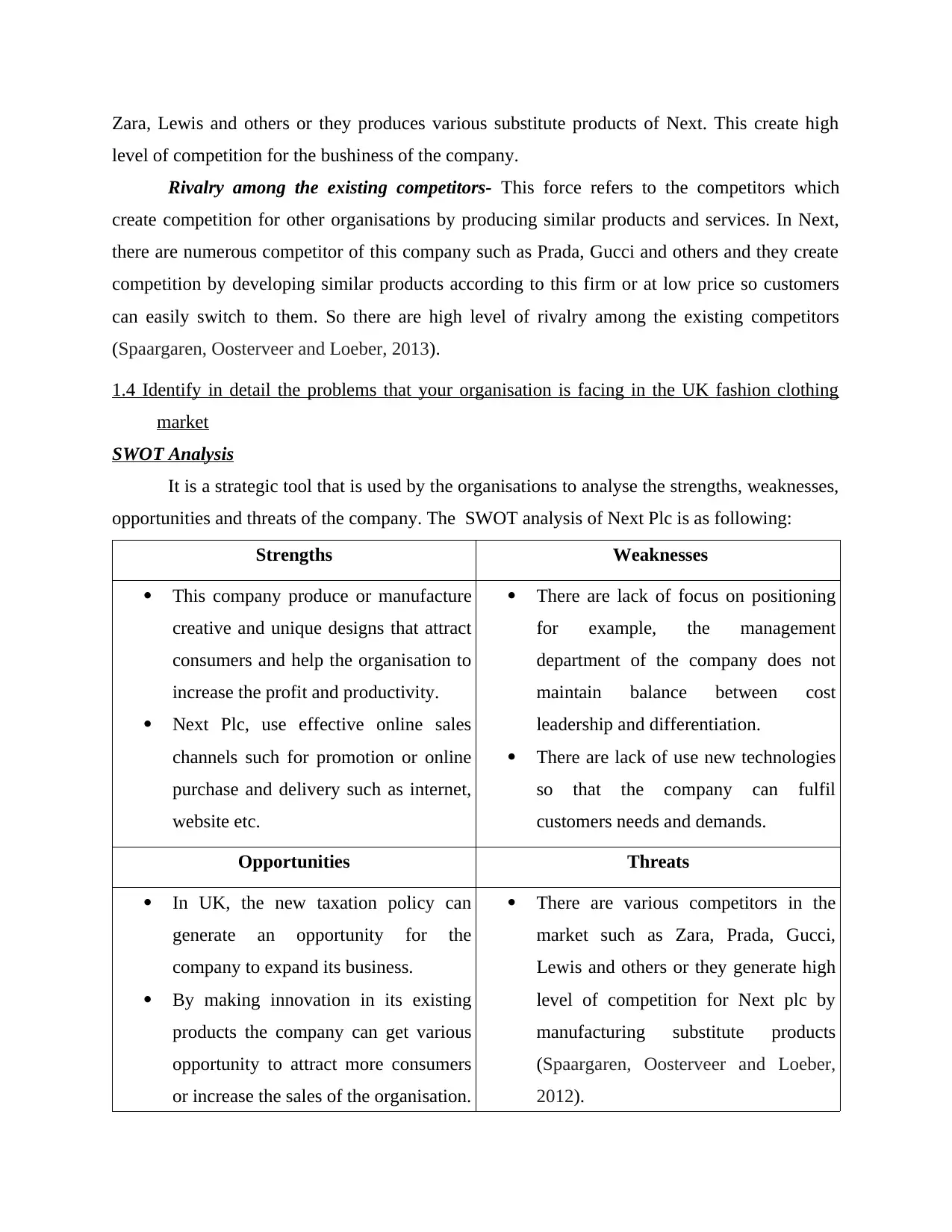
Zara, Lewis and others or they produces various substitute products of Next. This create high
level of competition for the bushiness of the company.
Rivalry among the existing competitors- This force refers to the competitors which
create competition for other organisations by producing similar products and services. In Next,
there are numerous competitor of this company such as Prada, Gucci and others and they create
competition by developing similar products according to this firm or at low price so customers
can easily switch to them. So there are high level of rivalry among the existing competitors
(Spaargaren, Oosterveer and Loeber, 2013).
1.4 Identify in detail the problems that your organisation is facing in the UK fashion clothing
market
SWOT Analysis
It is a strategic tool that is used by the organisations to analyse the strengths, weaknesses,
opportunities and threats of the company. The SWOT analysis of Next Plc is as following:
Strengths Weaknesses
This company produce or manufacture
creative and unique designs that attract
consumers and help the organisation to
increase the profit and productivity.
Next Plc, use effective online sales
channels such for promotion or online
purchase and delivery such as internet,
website etc.
There are lack of focus on positioning
for example, the management
department of the company does not
maintain balance between cost
leadership and differentiation.
There are lack of use new technologies
so that the company can fulfil
customers needs and demands.
Opportunities Threats
In UK, the new taxation policy can
generate an opportunity for the
company to expand its business.
By making innovation in its existing
products the company can get various
opportunity to attract more consumers
or increase the sales of the organisation.
There are various competitors in the
market such as Zara, Prada, Gucci,
Lewis and others or they generate high
level of competition for Next plc by
manufacturing substitute products
(Spaargaren, Oosterveer and Loeber,
2012).
level of competition for the bushiness of the company.
Rivalry among the existing competitors- This force refers to the competitors which
create competition for other organisations by producing similar products and services. In Next,
there are numerous competitor of this company such as Prada, Gucci and others and they create
competition by developing similar products according to this firm or at low price so customers
can easily switch to them. So there are high level of rivalry among the existing competitors
(Spaargaren, Oosterveer and Loeber, 2013).
1.4 Identify in detail the problems that your organisation is facing in the UK fashion clothing
market
SWOT Analysis
It is a strategic tool that is used by the organisations to analyse the strengths, weaknesses,
opportunities and threats of the company. The SWOT analysis of Next Plc is as following:
Strengths Weaknesses
This company produce or manufacture
creative and unique designs that attract
consumers and help the organisation to
increase the profit and productivity.
Next Plc, use effective online sales
channels such for promotion or online
purchase and delivery such as internet,
website etc.
There are lack of focus on positioning
for example, the management
department of the company does not
maintain balance between cost
leadership and differentiation.
There are lack of use new technologies
so that the company can fulfil
customers needs and demands.
Opportunities Threats
In UK, the new taxation policy can
generate an opportunity for the
company to expand its business.
By making innovation in its existing
products the company can get various
opportunity to attract more consumers
or increase the sales of the organisation.
There are various competitors in the
market such as Zara, Prada, Gucci,
Lewis and others or they generate high
level of competition for Next plc by
manufacturing substitute products
(Spaargaren, Oosterveer and Loeber,
2012).
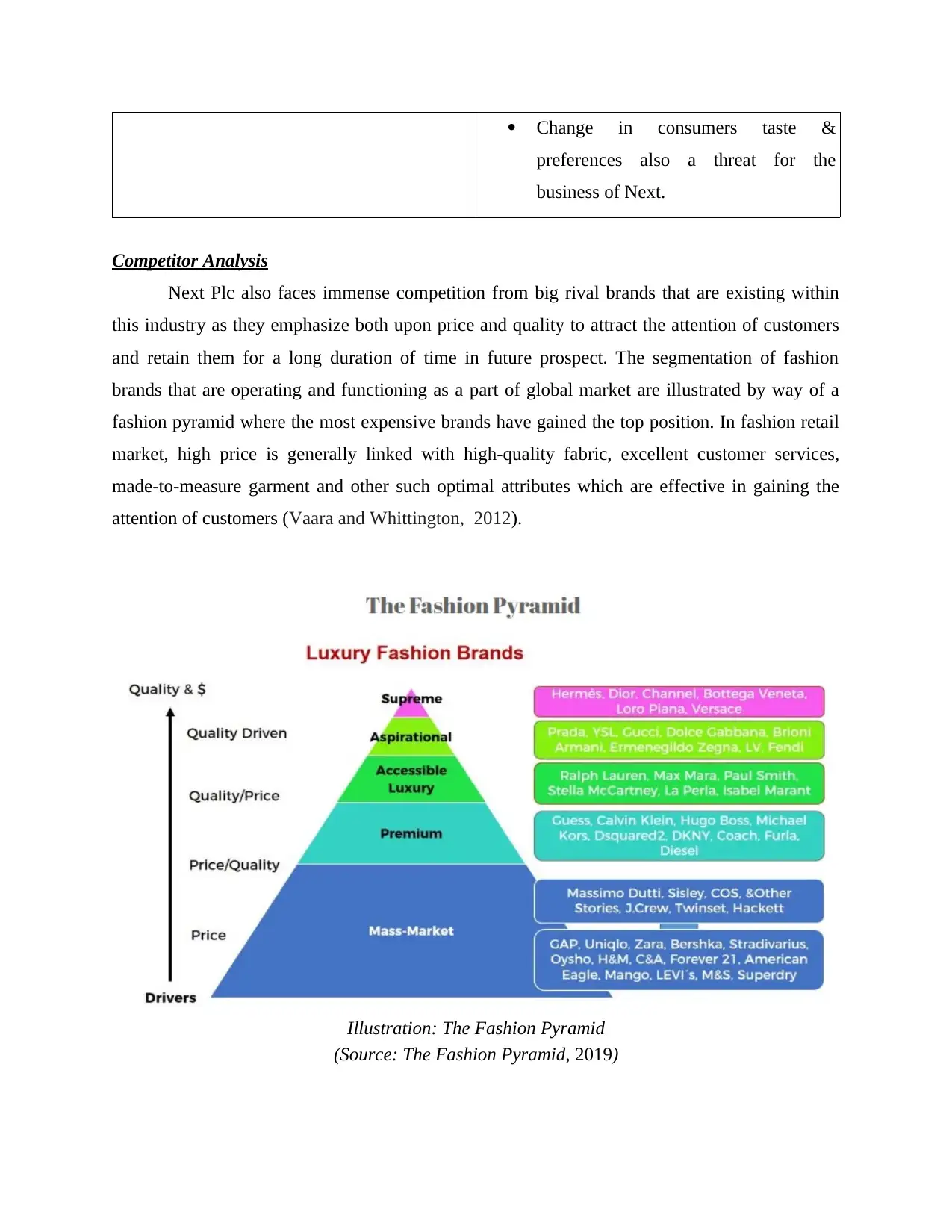
Change in consumers taste &
preferences also a threat for the
business of Next.
Competitor Analysis
Next Plc also faces immense competition from big rival brands that are existing within
this industry as they emphasize both upon price and quality to attract the attention of customers
and retain them for a long duration of time in future prospect. The segmentation of fashion
brands that are operating and functioning as a part of global market are illustrated by way of a
fashion pyramid where the most expensive brands have gained the top position. In fashion retail
market, high price is generally linked with high-quality fabric, excellent customer services,
made-to-measure garment and other such optimal attributes which are effective in gaining the
attention of customers (Vaara and Whittington, 2012).
(Source: The Fashion Pyramid, 2019)
Illustration: The Fashion Pyramid
preferences also a threat for the
business of Next.
Competitor Analysis
Next Plc also faces immense competition from big rival brands that are existing within
this industry as they emphasize both upon price and quality to attract the attention of customers
and retain them for a long duration of time in future prospect. The segmentation of fashion
brands that are operating and functioning as a part of global market are illustrated by way of a
fashion pyramid where the most expensive brands have gained the top position. In fashion retail
market, high price is generally linked with high-quality fabric, excellent customer services,
made-to-measure garment and other such optimal attributes which are effective in gaining the
attention of customers (Vaara and Whittington, 2012).
(Source: The Fashion Pyramid, 2019)
Illustration: The Fashion Pyramid
⊘ This is a preview!⊘
Do you want full access?
Subscribe today to unlock all pages.

Trusted by 1+ million students worldwide
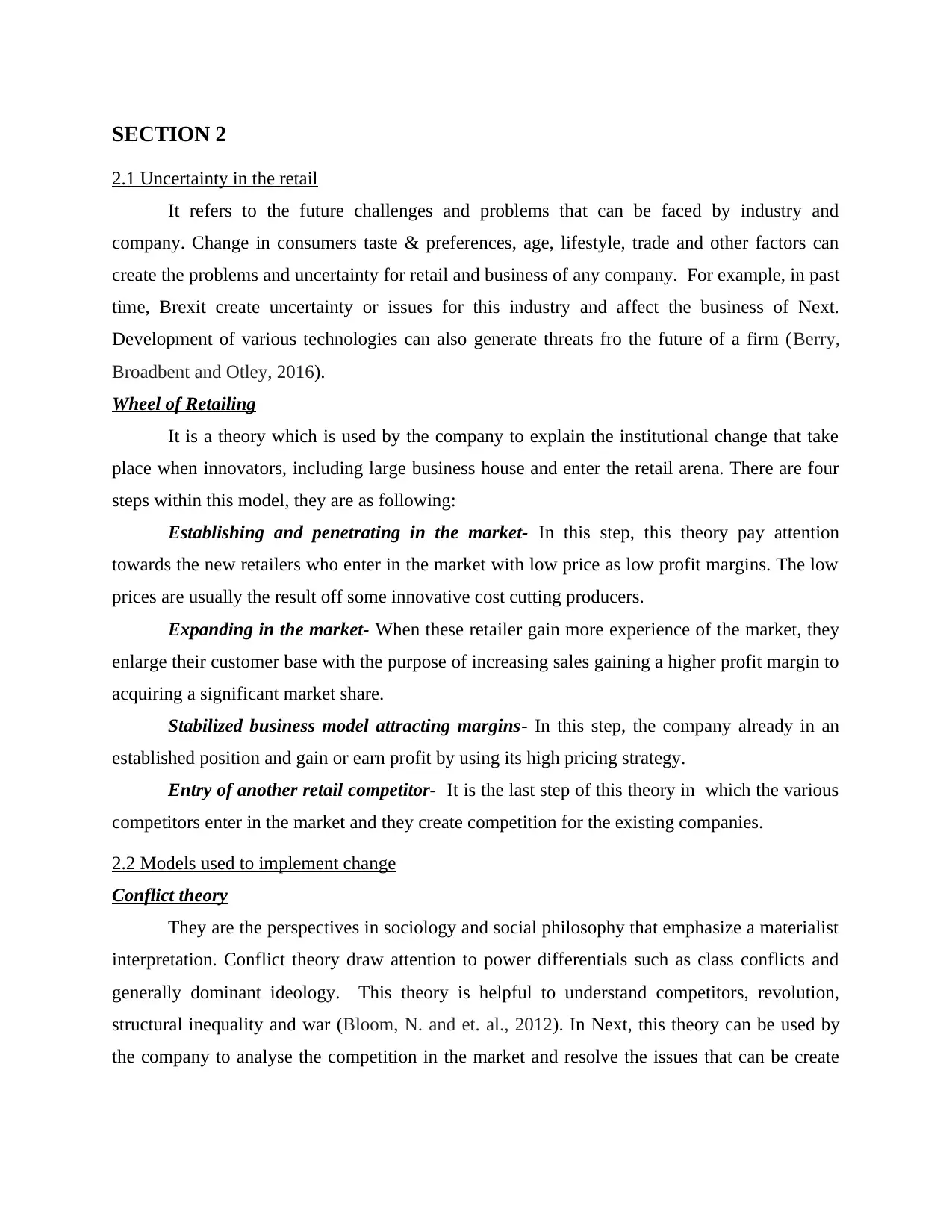
SECTION 2
2.1 Uncertainty in the retail
It refers to the future challenges and problems that can be faced by industry and
company. Change in consumers taste & preferences, age, lifestyle, trade and other factors can
create the problems and uncertainty for retail and business of any company. For example, in past
time, Brexit create uncertainty or issues for this industry and affect the business of Next.
Development of various technologies can also generate threats fro the future of a firm (Berry,
Broadbent and Otley, 2016).
Wheel of Retailing
It is a theory which is used by the company to explain the institutional change that take
place when innovators, including large business house and enter the retail arena. There are four
steps within this model, they are as following:
Establishing and penetrating in the market- In this step, this theory pay attention
towards the new retailers who enter in the market with low price as low profit margins. The low
prices are usually the result off some innovative cost cutting producers.
Expanding in the market- When these retailer gain more experience of the market, they
enlarge their customer base with the purpose of increasing sales gaining a higher profit margin to
acquiring a significant market share.
Stabilized business model attracting margins- In this step, the company already in an
established position and gain or earn profit by using its high pricing strategy.
Entry of another retail competitor- It is the last step of this theory in which the various
competitors enter in the market and they create competition for the existing companies.
2.2 Models used to implement change
Conflict theory
They are the perspectives in sociology and social philosophy that emphasize a materialist
interpretation. Conflict theory draw attention to power differentials such as class conflicts and
generally dominant ideology. This theory is helpful to understand competitors, revolution,
structural inequality and war (Bloom, N. and et. al., 2012). In Next, this theory can be used by
the company to analyse the competition in the market and resolve the issues that can be create
2.1 Uncertainty in the retail
It refers to the future challenges and problems that can be faced by industry and
company. Change in consumers taste & preferences, age, lifestyle, trade and other factors can
create the problems and uncertainty for retail and business of any company. For example, in past
time, Brexit create uncertainty or issues for this industry and affect the business of Next.
Development of various technologies can also generate threats fro the future of a firm (Berry,
Broadbent and Otley, 2016).
Wheel of Retailing
It is a theory which is used by the company to explain the institutional change that take
place when innovators, including large business house and enter the retail arena. There are four
steps within this model, they are as following:
Establishing and penetrating in the market- In this step, this theory pay attention
towards the new retailers who enter in the market with low price as low profit margins. The low
prices are usually the result off some innovative cost cutting producers.
Expanding in the market- When these retailer gain more experience of the market, they
enlarge their customer base with the purpose of increasing sales gaining a higher profit margin to
acquiring a significant market share.
Stabilized business model attracting margins- In this step, the company already in an
established position and gain or earn profit by using its high pricing strategy.
Entry of another retail competitor- It is the last step of this theory in which the various
competitors enter in the market and they create competition for the existing companies.
2.2 Models used to implement change
Conflict theory
They are the perspectives in sociology and social philosophy that emphasize a materialist
interpretation. Conflict theory draw attention to power differentials such as class conflicts and
generally dominant ideology. This theory is helpful to understand competitors, revolution,
structural inequality and war (Bloom, N. and et. al., 2012). In Next, this theory can be used by
the company to analyse the competition in the market and resolve the issues that can be create
Paraphrase This Document
Need a fresh take? Get an instant paraphrase of this document with our AI Paraphraser
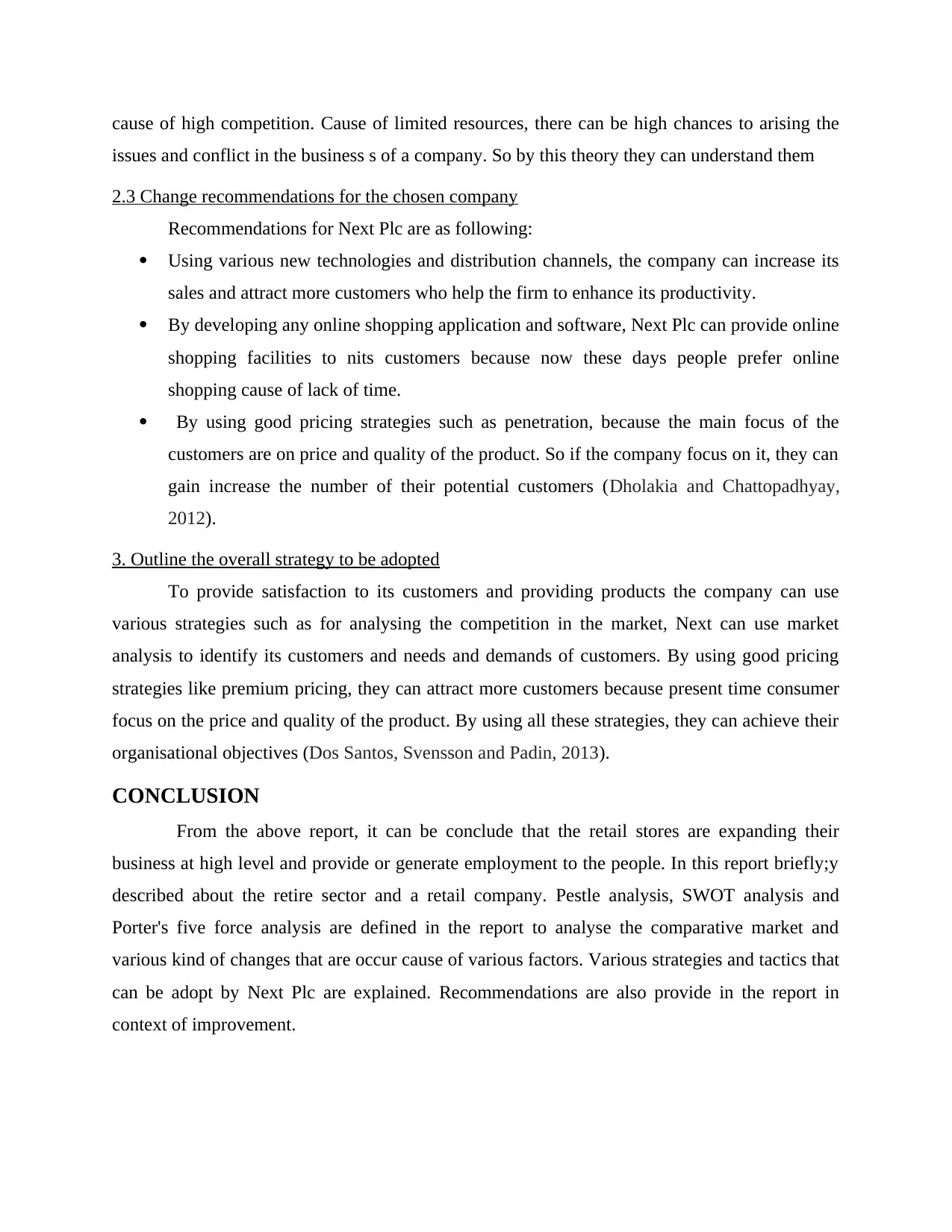
cause of high competition. Cause of limited resources, there can be high chances to arising the
issues and conflict in the business s of a company. So by this theory they can understand them
2.3 Change recommendations for the chosen company
Recommendations for Next Plc are as following:
Using various new technologies and distribution channels, the company can increase its
sales and attract more customers who help the firm to enhance its productivity.
By developing any online shopping application and software, Next Plc can provide online
shopping facilities to nits customers because now these days people prefer online
shopping cause of lack of time.
By using good pricing strategies such as penetration, because the main focus of the
customers are on price and quality of the product. So if the company focus on it, they can
gain increase the number of their potential customers (Dholakia and Chattopadhyay,
2012).
3. Outline the overall strategy to be adopted
To provide satisfaction to its customers and providing products the company can use
various strategies such as for analysing the competition in the market, Next can use market
analysis to identify its customers and needs and demands of customers. By using good pricing
strategies like premium pricing, they can attract more customers because present time consumer
focus on the price and quality of the product. By using all these strategies, they can achieve their
organisational objectives (Dos Santos, Svensson and Padin, 2013).
CONCLUSION
From the above report, it can be conclude that the retail stores are expanding their
business at high level and provide or generate employment to the people. In this report briefly;y
described about the retire sector and a retail company. Pestle analysis, SWOT analysis and
Porter's five force analysis are defined in the report to analyse the comparative market and
various kind of changes that are occur cause of various factors. Various strategies and tactics that
can be adopt by Next Plc are explained. Recommendations are also provide in the report in
context of improvement.
issues and conflict in the business s of a company. So by this theory they can understand them
2.3 Change recommendations for the chosen company
Recommendations for Next Plc are as following:
Using various new technologies and distribution channels, the company can increase its
sales and attract more customers who help the firm to enhance its productivity.
By developing any online shopping application and software, Next Plc can provide online
shopping facilities to nits customers because now these days people prefer online
shopping cause of lack of time.
By using good pricing strategies such as penetration, because the main focus of the
customers are on price and quality of the product. So if the company focus on it, they can
gain increase the number of their potential customers (Dholakia and Chattopadhyay,
2012).
3. Outline the overall strategy to be adopted
To provide satisfaction to its customers and providing products the company can use
various strategies such as for analysing the competition in the market, Next can use market
analysis to identify its customers and needs and demands of customers. By using good pricing
strategies like premium pricing, they can attract more customers because present time consumer
focus on the price and quality of the product. By using all these strategies, they can achieve their
organisational objectives (Dos Santos, Svensson and Padin, 2013).
CONCLUSION
From the above report, it can be conclude that the retail stores are expanding their
business at high level and provide or generate employment to the people. In this report briefly;y
described about the retire sector and a retail company. Pestle analysis, SWOT analysis and
Porter's five force analysis are defined in the report to analyse the comparative market and
various kind of changes that are occur cause of various factors. Various strategies and tactics that
can be adopt by Next Plc are explained. Recommendations are also provide in the report in
context of improvement.
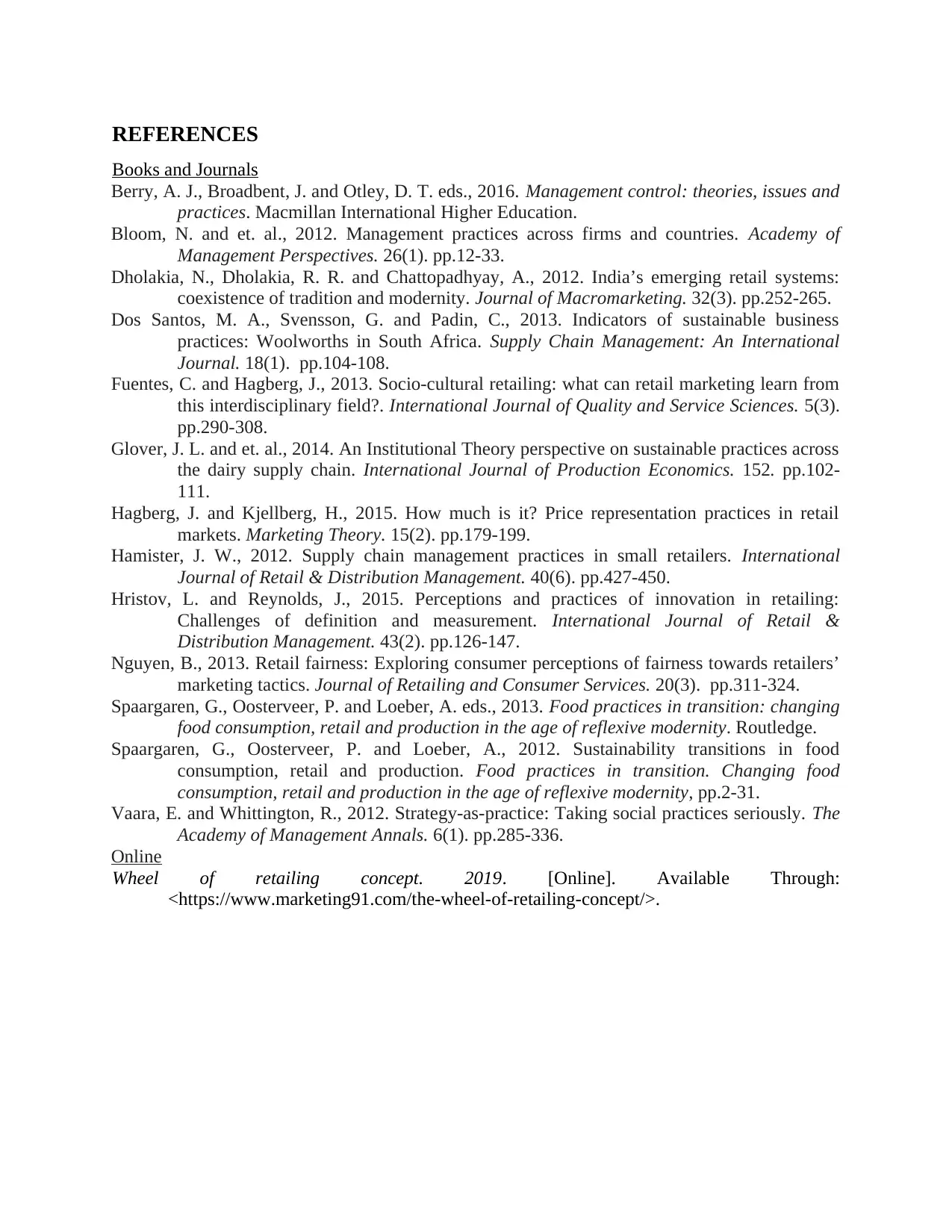
REFERENCES
Books and Journals
Berry, A. J., Broadbent, J. and Otley, D. T. eds., 2016. Management control: theories, issues and
practices. Macmillan International Higher Education.
Bloom, N. and et. al., 2012. Management practices across firms and countries. Academy of
Management Perspectives. 26(1). pp.12-33.
Dholakia, N., Dholakia, R. R. and Chattopadhyay, A., 2012. India’s emerging retail systems:
coexistence of tradition and modernity. Journal of Macromarketing. 32(3). pp.252-265.
Dos Santos, M. A., Svensson, G. and Padin, C., 2013. Indicators of sustainable business
practices: Woolworths in South Africa. Supply Chain Management: An International
Journal. 18(1). pp.104-108.
Fuentes, C. and Hagberg, J., 2013. Socio-cultural retailing: what can retail marketing learn from
this interdisciplinary field?. International Journal of Quality and Service Sciences. 5(3).
pp.290-308.
Glover, J. L. and et. al., 2014. An Institutional Theory perspective on sustainable practices across
the dairy supply chain. International Journal of Production Economics. 152. pp.102-
111.
Hagberg, J. and Kjellberg, H., 2015. How much is it? Price representation practices in retail
markets. Marketing Theory. 15(2). pp.179-199.
Hamister, J. W., 2012. Supply chain management practices in small retailers. International
Journal of Retail & Distribution Management. 40(6). pp.427-450.
Hristov, L. and Reynolds, J., 2015. Perceptions and practices of innovation in retailing:
Challenges of definition and measurement. International Journal of Retail &
Distribution Management. 43(2). pp.126-147.
Nguyen, B., 2013. Retail fairness: Exploring consumer perceptions of fairness towards retailers’
marketing tactics. Journal of Retailing and Consumer Services. 20(3). pp.311-324.
Spaargaren, G., Oosterveer, P. and Loeber, A. eds., 2013. Food practices in transition: changing
food consumption, retail and production in the age of reflexive modernity. Routledge.
Spaargaren, G., Oosterveer, P. and Loeber, A., 2012. Sustainability transitions in food
consumption, retail and production. Food practices in transition. Changing food
consumption, retail and production in the age of reflexive modernity, pp.2-31.
Vaara, E. and Whittington, R., 2012. Strategy-as-practice: Taking social practices seriously. The
Academy of Management Annals. 6(1). pp.285-336.
Online
Wheel of retailing concept. 2019. [Online]. Available Through:
<https://www.marketing91.com/the-wheel-of-retailing-concept/>.
Books and Journals
Berry, A. J., Broadbent, J. and Otley, D. T. eds., 2016. Management control: theories, issues and
practices. Macmillan International Higher Education.
Bloom, N. and et. al., 2012. Management practices across firms and countries. Academy of
Management Perspectives. 26(1). pp.12-33.
Dholakia, N., Dholakia, R. R. and Chattopadhyay, A., 2012. India’s emerging retail systems:
coexistence of tradition and modernity. Journal of Macromarketing. 32(3). pp.252-265.
Dos Santos, M. A., Svensson, G. and Padin, C., 2013. Indicators of sustainable business
practices: Woolworths in South Africa. Supply Chain Management: An International
Journal. 18(1). pp.104-108.
Fuentes, C. and Hagberg, J., 2013. Socio-cultural retailing: what can retail marketing learn from
this interdisciplinary field?. International Journal of Quality and Service Sciences. 5(3).
pp.290-308.
Glover, J. L. and et. al., 2014. An Institutional Theory perspective on sustainable practices across
the dairy supply chain. International Journal of Production Economics. 152. pp.102-
111.
Hagberg, J. and Kjellberg, H., 2015. How much is it? Price representation practices in retail
markets. Marketing Theory. 15(2). pp.179-199.
Hamister, J. W., 2012. Supply chain management practices in small retailers. International
Journal of Retail & Distribution Management. 40(6). pp.427-450.
Hristov, L. and Reynolds, J., 2015. Perceptions and practices of innovation in retailing:
Challenges of definition and measurement. International Journal of Retail &
Distribution Management. 43(2). pp.126-147.
Nguyen, B., 2013. Retail fairness: Exploring consumer perceptions of fairness towards retailers’
marketing tactics. Journal of Retailing and Consumer Services. 20(3). pp.311-324.
Spaargaren, G., Oosterveer, P. and Loeber, A. eds., 2013. Food practices in transition: changing
food consumption, retail and production in the age of reflexive modernity. Routledge.
Spaargaren, G., Oosterveer, P. and Loeber, A., 2012. Sustainability transitions in food
consumption, retail and production. Food practices in transition. Changing food
consumption, retail and production in the age of reflexive modernity, pp.2-31.
Vaara, E. and Whittington, R., 2012. Strategy-as-practice: Taking social practices seriously. The
Academy of Management Annals. 6(1). pp.285-336.
Online
Wheel of retailing concept. 2019. [Online]. Available Through:
<https://www.marketing91.com/the-wheel-of-retailing-concept/>.
⊘ This is a preview!⊘
Do you want full access?
Subscribe today to unlock all pages.

Trusted by 1+ million students worldwide
1 out of 12
Related Documents
Your All-in-One AI-Powered Toolkit for Academic Success.
+13062052269
info@desklib.com
Available 24*7 on WhatsApp / Email
![[object Object]](/_next/static/media/star-bottom.7253800d.svg)
Unlock your academic potential
Copyright © 2020–2025 A2Z Services. All Rights Reserved. Developed and managed by ZUCOL.




